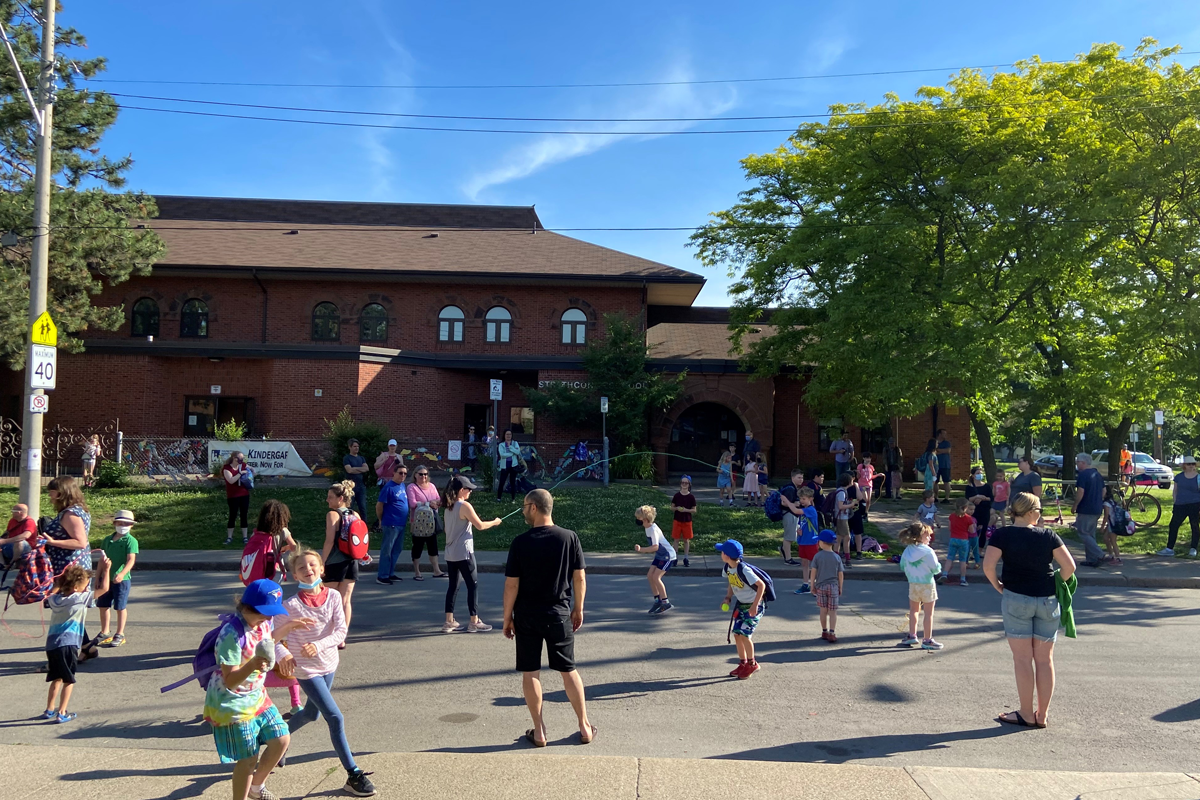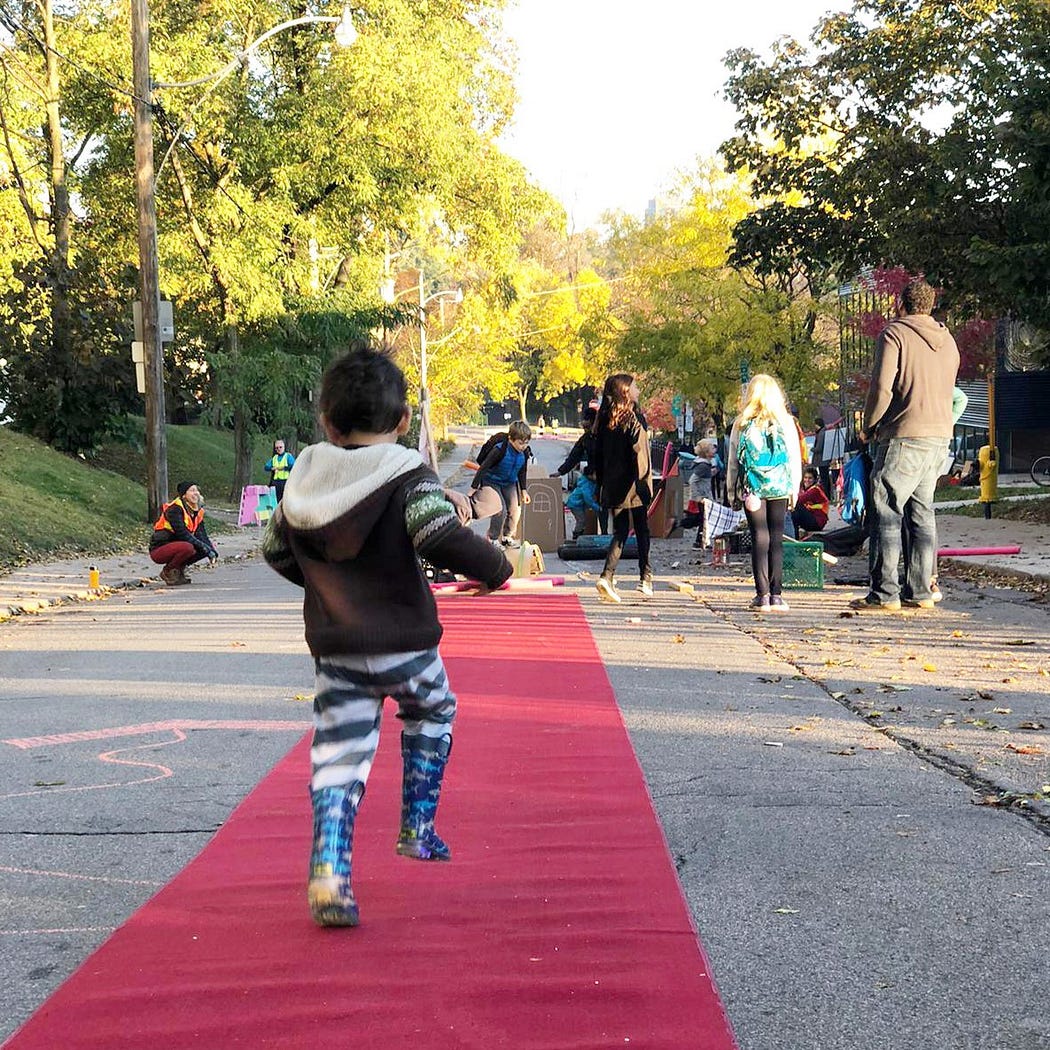
04 Oct Reimagining North American Streets for Safe, Active, and Joyful Trips to School
This article was published in the 2023 Vision Zero Cities Journal. To learn more from leading industry and policy experts, advocates, and elected officials from across the nation, join us at the Vision Zero Cities conference held October 18-20 in New York City and virtually. Explore the challenges and opportunities facing us as we work to build a world with zero traffic deaths by registering at visionzerocities.org.”
By Amanda O’Rourke
Ask any parent or caregiver about the school drop-off and pick-up routine, and chances are most would describe it as a stressful experience. Twice a day, the streets in front of a typical school in North American cities and towns begin to resemble parking lots. They’ve not only become places of stress and frustration but also some of the most dangerous places for children. In Montreal, the average distance between a child road injury and a school is less than 500 metres. The streets in front of schools — which should support healthy child development — are endangering kids.
How did we get here?
Only one in four Canadian children and one in ten American children walk or bike to school, while most kids are driven. This wasn’t always the case in either country. In fact, this number has declined sharply in the last few decades: in 1969, nearly half of children aged 5–14 walked or biked to school in the U.S. In Canada, the trends have been similar, with a 30% decrease in just one generation.

Across the United States, 10–14% of car trips during morning rush hour are for school travel alone. More children being driven to school not only contributes to traffic jams around schools and stresses out parents, but also makes the walk or bike ride to school less safe and a less attractive option. Ironically, fear of traffic danger is consistently one of the top reasons parents and caregivers don’t let their children walk or cycle to school. And they are right to be concerned: a 2016 study by York University and the Hospital for Sick Children in my home city of Toronto recorded dangerous driving behaviour at 88% of the over 100 elementary schools. Each additional dangerous driving behaviour was associated with a 45% increase in collision rates. In addition, lower-income communities with higher levels of social disadvantage were associated with higher collision rates and increased danger. In the span of 12 years, more than 400 children were hit by a car within 200 metres of the schools the researchers monitored.
Traffic danger has become so bad around schools that school principals now must spend their mornings and afternoons managing traffic. A survey conducted with school principals across the province of Ontario found that they collectively spend an estimated 720,000 hours a year coping with traffic problems around schools.
And herein lies the vicious cycle and conundrum. More people driving leads to more dangerous conditions around schools, which encourages more people to drive, which makes it increasingly unsafe. So, how do we start to break the cycle?
This question inspired the launch of Toronto’s first-ever School Streets pop-up in 2019, initiated by 8 80 Cities.
School Streets are programs that create a car-free space in front of schools at the start and end of the school day to prioritize the safety of children, caregivers, and teachers. School Streets originated in Bolzano, Italy in the early 1990s when school communities struggled to manage traffic during peak pick-up and drop-off hours, and finally decided that the cars had to go. This model of establishing temporary car-free zones has been replicated in other cities around the world, like Edinburgh, London, and Odense, Denmark.
Our team was inspired by the success of the School Streets initiatives in Bolzano and in London’s borough of Hackney. 8 80 Cities had received funding from a private donor to accelerate action on Vision Zero in Toronto and launched 8 80 Streets, a series of demonstrations of how to create safer streets on three different street typologies: a commercial street, a neighbourhood street, and a School Street.
Our goal with the School Street project was to highlight its many benefits, including improving safety and reducing road danger for children on their school journey, increasing social and community connection before and after school, improving air quality around schools, encouraging independent mobility and physical activity, and reducing traffic congestion.

At our first pop-up School Street on Toronto’s Mountview Ave, I was amazed at the simplicity of its execution and the immediate impact. We chose a school that had identified traffic congestion around the school as a safety concern and worked closely with the principal, teachers, students, and broader community to bring about a four-day trial event. We used simple, colorfully painted barricades and volunteers to temporarily close approximately 100 meters in front of the school for one hour in the morning and one hour in the afternoon.
Our goals were less about collecting robust data and more about introducing and testing a new concept. We wanted to make a big splash in the media, so we held a media event with speakers including the students that helped make it happen, parents, the local councillor, and volunteers. We also rolled out a beautiful red carpet for the kids on the first day. We wanted a clear and bold image and story to tell — what does a School Street look like when we make the children VIPs?
While we successfully garnered attention, we also saw some compelling data trends emerge in just four days. The pilot increased children’s active travel by over 5% and decreased car travel by 20%, while participants’ perceptions of safety improved. This motivated us to build more robust pilot programs where we could intentionally engage municipal partners and community stakeholders to implement and evaluate School Streets on a larger scale.

The first pop-up in 2019 hit a nerve and sparked interest in Canada and abroad. While the pandemic stalled the immediate implementation of pilot programs, we forged ahead with planning to be ready when children returned to in-person learning.
In late 2021, 8 80 Cities formed an important and strategic partnership with Green Communities Canada, a longtime advocate and national program lead for active and safe routes to school. In the spring of 2022, we successfully piloted School Streets at a larger scale with four communities in Ontario and were able to collect detailed results.
There were 11 key findings supported by compelling data from our pilot communities:
- School Streets encourage walking and cycling.
- School Streets support community-building and social connection.
- School Streets raise community awareness of road safety issues.
- School Streets do not increase traffic on surrounding streets.
- School Streets improve air quality in front of schools during the closure periods.
- Each School Street must be unique to each site.
- A plan for project implementation is vital for reassuring critics.
- There is no standardized municipal permit process for School Streets.
- Municipal participation and support are key factors for success.
- Peer-to-peer support across School Street sites aids the planning process.
- Communities are eager for more opportunities to use the road as public space.
Not only have we seen success from our Ontario pilot, but we’ve also seen more and more publications, articles, toolkits, videos, and webinars about School Streets being produced over the last five years, signaling that School Streets are gaining traction.
While we have a growing body of data and research that supports the benefits of School Streets, my ultimate motivation comes from that first day of our School Street pop-up in Toronto. The moment we put those barricades up and rolled out the carpet, looks of sheer joy, freedom of movement, and playfulness took over the children. Without noise from idling cars, I could hear and notice birdsongs, conversations between parents, and children playing. This felt like a much more humane and less stressful way to start and end a school day. It is a reminder that Vision Zero is as much about eliminating death on our streets as it is about facilitating a new kind of life on the street.
Amanda O’Rourke is the Executive Director of 8 80 Cities, a non-profit organization with a mission to ignite action and challenge the status quo to create healthier, more equitable, and sustainable cities for all people. She has over 20 years of experience leading diverse equitable mobility and public space projects in cities and towns in North America, Europe, and Australia. She enjoys working collaboratively with city governments and communities to leverage creative and fun placemaking strategies to support broader systems change. She lives in Toronto with her partner and three energetic kids.



